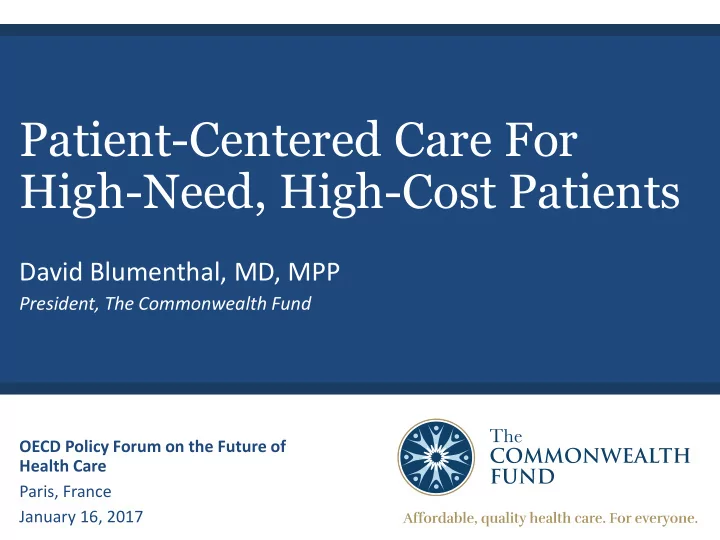

Patient-Centered Care For High-Need, High-Cost Patients David Blumenthal, MD, MPP President, The Commonwealth Fund OECD Policy Forum on the Future of Health Care Paris, France January 16, 2017
2 Agenda a) Who is the high-need, high-cost patient? b) A patient-centered approach to the high-need, high-cost individual? c) The implementation challenge. d) Commonwealth Fund agenda.
Who is the high-need, high-cost patient?
4 U.S. High-Need Adults Tend to be Older, Have Low Socioeconomic Status, and Have Public Insurance All adults High-need adults (3+ chronic conditions & functional limitation) 83% 55% 52% 30% 28% 28% 17% 16% Age 65+ No high school Income below 200% Public insurance degree FPL Data: 2009 – 2011 Medical Expenditure Panel Survey (MEPS). Source: S. L. Hayes, et al., High-Need, High-Cost Patients: Who Are They and How Do They Use Health Care? The Commonwealth Fund, August 2016.
Behavioral Health Issues are a Key 5 Predictor of High Costs Average Annual Health Expenditures Among a U.S. Medicaid Population $40,000 No mental illness or drug/alcohol problem Mental illness but no drug/alcohol problem $35,000 Mental illness and drug/alcohol problem $30,000 $25,000 $20,000 $15,000 $10,000 $5,000 $0 Asthma/COPD Congestive heart Coronary heart Diabetes Hypertension failure disease Source: C. Boyd et al. Clarifying Multimorbidity Patterns to Improve Targeting and Delivery of Clinical Services for Medicaid Populations. Center for Healthcare Strategies Data Brief, December 2010.
6 In the U.S., Health Care Costs Concentrated in Sick Few — Sickest 5% Account for 49% of Expenses Distribution of health expenditures for the U.S. population, by magnitude of expenditure, 2013 Population Share of Health Spending 1% 5% 10% 22% 49% 50% 65% 97% Source: Agency for Healthcare Research and Quality analysis of 2013 Medical Expenditure Panel Survey; MEPS Statistical Brief 480.
7 In Ontario, Sickest 5% Account for 61% of Hospital and Home Care Services Expenses Distribution of hospital and home care expenditures for the Ontario population, by magnitude of expenditure, 2009/10 Population Share of Health Spending 5% 61% Source: Saad R, et al., “High - Cost Users of Ontario’s Healthcare Services,” Healthcare Policy , 2013.
8 In Scotland, Sickest 2% Account for 50% of Hospital and Pharmacy Expenses Share of expenditures (%) Share of service users (%) Note: Costs are for hospital and community pharmacy services only. Source: Correspondence with Health and Social Care Analytical Services.
9 Getting to Patient-Centeredness Segmentation Strategies
10 Segments of High-Cost Patients in U.S. Medicare 39.5% 25.6% 20.1% 10.2% 1.1% 3.6% Frail Elderly Under 65 Major Minor Simple Relatively Disabled Complex Complex Chronic Healthy Chronic Chronic Source: Ashish Jha, analysis of Medicare data.
11 Getting to Patient-Centeredness User-Centered Design EMOTIONAL NEEDS PERSONAL MEDICAL NEEDS NEEDS FUNCTIONAL NEEDS Source: http://www.sagehealthadvisor.com/
Esther Project (Sweden)
14 Improving Performance Microsystems Health System Performance Macrosystems
15 Implementation Challenges Payment policy Culture Macrosystems Integrating social and Workforce medical services
16 Implementation Challenges Engage clinical Share decision- leaders making with patients Microsystems Support informal Identify at-risk patients caregivers
17 The Commonwealth Fund • Five Foundation Collaborative. • Cross-national working group. • IT-enabled consumer engagement.
18
19 Vision of the Digital Health Advisor Tracking Communication Coordination Advice
20 Commonwealth Fund International Experts Working Group on Patients with Complex Needs • Established in 2014 (with LSE). • Aims: o Learn from international experts. o Develop recommendations for policymakers . o Identify promising frontline delivery system innovations. • Product: Ten recommendations for policymakers.
Recommend
More recommend